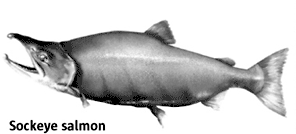forum
library
tutorial
contact

Summertime, and the Fishing is Perplexing
by James F. VeselyThe Seattle Times, July 27, 2008
|
the film forum library tutorial contact |

|
Summertime, and the Fishing is Perplexingby James F. VeselyThe Seattle Times, July 27, 2008 |
 In summer, an old man's thoughts turn to fishing. Among the perplexities of living in this grand trough of the Puget Sound region is the puzzle of where the fish are, and who will most exploit the ghosts of the gray seas for their political purposes.
In summer, an old man's thoughts turn to fishing. Among the perplexities of living in this grand trough of the Puget Sound region is the puzzle of where the fish are, and who will most exploit the ghosts of the gray seas for their political purposes.
Surprising news came Friday with announcement that a proud fish, nearly listed among the last of its kind, has returned to Washington and Oregon rivers and shores in large numbers. This season brings a ton of sockeye salmon to us, a bounty of fish - the largest arrival of the salmon in 50 years of recording the runs.
What to make of this? The politics of salmon insist that the fish is declining, we must do everything, including buffering every stream, to permit fish to live unhindered. And yet, abundance comes strolling along as if all our deeds have little to do with the turning of the sun and the homing sense of the wild sockeye.
Reporting from Portland, Ore., writer Scott Learn reveals that returning sockeye on the Columbia River are arriving in astounding numbers, the largest count in five decades. As Learn reported in The Seattle Times, the resulting confusion over why such a large arrival of fish leads - and anyone would guess - to fights over why this is happening.
It helps the fish managers and the dam operators to see a healthy run of salmon on the Columbia by validating their actions; it does not help environmentalists who insist we are living on borrowed time with declining salmon populations. Both sides are armed with the most sophisticated statistics imaginable to prove their point.
Yet the numbers of fish are epic. Learn reports as of last Tuesday, 215,000 red salmon were counted at Bonneville Dam, the largest number since 1938.
In truth, no one knows exactly why the fish thrive some years and are depleted the next. Name your poison: the dams, climate change, overfishing, overdevelopment, pollution, indifference. Or name your reason: the oceans are unpredictable purveyors of bounty, sustainable fisheries produce good harvests and are working.
"The first thing to keep in mind is that this is a snapshot," said National Oceanographic and Atmospheric Administration spokesman Brian Gorman in Seattle.
"The record run of sockeye on the Columbia is a complete surprise to everyone - a welcome one, but it doesn't mean much in the longer cycle of fish populations," Gorman said.
"Some of the early discussions put the success of the Columbia runs this year to the increase spillage over the Columbia dams in 2006 and 2007, which more allowed young fish to move out to sea.
"We take issue with that," Gorman said.
"NOAA believes the real driver is the ocean. It isn't just one big ocean out there, ocean conditions vary and touch everything. We had a ban on West Coast fisheries at one point, and the sockeye in Puget Sound are still listed as endangered - as are Puget Sound orcas - so you can't take one fish run and use it to talk about other runs," he said.
That's the confusing part. Despite everything - court orders, stream reparation, dams spilling water like Niagara or eight dams over 450 miles holding water stone-tight, overfishing or fishing bans - the eternal currents of the sea keep their mysteries.
"Biologists can figure this out, and have theories that appear sound" Gorman said, "but nobody can predict with total accuracy when the next surprise is coming."
learn more on topics covered in the film
see the video
read the script
learn the songs
discussion forum
